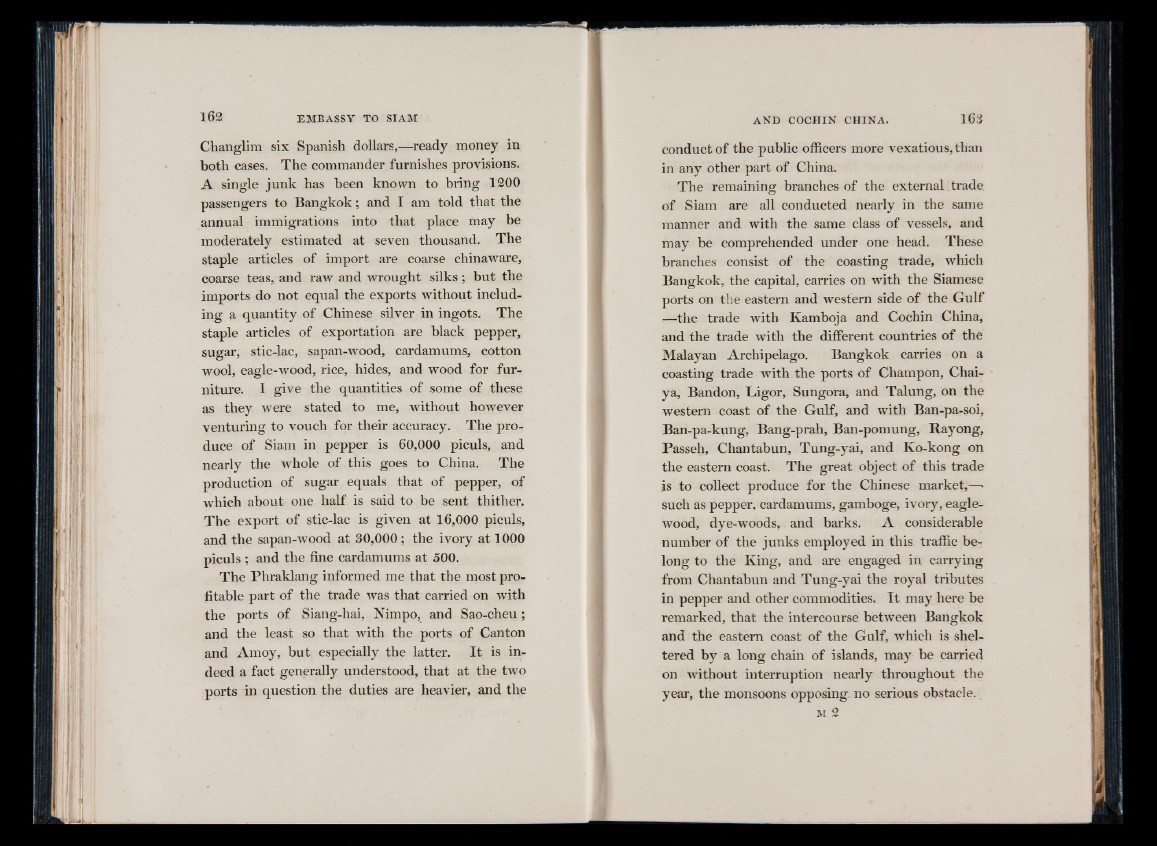
Changlim six Spanish dollars,—ready money in
both cases. The commander furnishes provisions.
A single junk has been known to bring 1200
passengers to Bangkok; and I am told that the
annual immigrations into that place may be
moderately estimated at seven thousand. The
staple articles of import are coarse chinaware,
coarse teas, and raw and wrought silks; but the
imports do not equal the exports without including
a quantity of Chinese silver in ingots. The
staple articles of exportation are black pepper,
sugar, stic-lac, sapan-wood, cardamums, cotton
wool, eagle-wood, rice, hides, and wood for furniture.
I give the quantities of some of these
as tbey were stated to me, without however
venturing to vouch for their accuracy. The produce
of Siam in pepper is 60,000 piculs, and
nearly the whole of this goes to China. The
production of sugar equals that of pepper, of
which about one half is said to be sent thither.
The export of stic-lac is given at 16,000 piculs,
and the sapan-wood at 30,000 ; the ivory at 1000
piculs ; and the fine cardamums at 500.
The Phraklang informed me that the most profitable
part of the trade was that carried on with
the ports of Siang-hai, Nimpo, and Sao-cheu;
and the least so that with the ports of Canton
and Amoy, but especially the latter. I t is indeed
a fact generally understood, that at the two
ports in question the duties are heavier, and the
conduct of the public officers more vexatious, than
in any other part of China.
The remaining branches of the external trade
of Siam are all conducted nearly in the same
manner and with the same class of vessels, and
may be comprehended under one head. These
branches consist of the coasting trade, which
Bangkok, the capital, carries on with the Siamese
ports on the eastern and western side of the Gulf
—the trade with Kamboja and Cochin China,
and the trade with the different countries of the
Malayan Archipelago. Bangkok carries on a
coasting trade with the ports of Champon, Chai-
ya, Bandon, Lagor, Sungora, and Talung, on the
western coast of the Gulf, and with Ban-pa-soi,
Ban-pa-kung, Bang-prah, Ban-pomung, Rayong,
Passeh, Chantabun, Tung-yai, and Ko-kong on
the eastern coast. The great object of this trade
is to collect produce for the Chinese market,—
such as pepper, cardamums, gamboge, ivory, eagle-
wood, dye-woods, and barks. A considerable
number of the junks employed in this traffic belong
to the King, and are engaged in carrying
from Chantabun and Tung-yai the royal tributes
in pepper and other commodities. I t may here be
remarked, that the intercourse between Bangkok
and the eastern coast of the Gulf, which is sheltered
by a long chain of islands, may be carried
on without interruption nearly throughout the
year, the monsoons opposing, no serious obstacle.
M 2